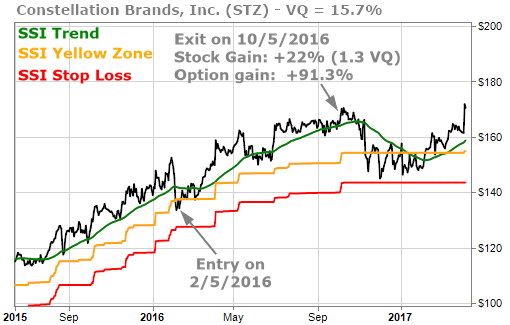The research team just uncovered an incredible strategy for option traders. And the trigger is from an unlikely source.
Earlier in the year, we presented you with a way to maximize the returns on your covered call trades. We looked at how long it could take for a stock to move 1 Volatility Quotient (VQ) unit and how to use that information to set the parameters for selling covered calls.
This new research is best used for bullish option trades, especially long calls (that’s when you buy a call and are looking for a gain in the underlying stock price to profit from the option trade).
It’s amazing research that I didn’t see coming…and today we’re sharing it with you. Here’s how it works.
The TradeStops Stock State Indicator (SSI) is a red / yellow / green light system that tells us:
- When a stock is strong (green),
- When a stock has pulled back but not yet stopped out (yellow); and
- When a stock has corrected more than expected and is currently stopped out (red).
The TradeStops SSI was intentionally designed to be a conservative indicator. The first goal of TradeStops is to help investors capture large medium to long-term gains. It should come as no surprise then, that an options strategy leveraging the TradeStops SSI is going to be a little longer term than other options strategies.
Our new options strategy is incredibly simple.
- Wait for the TradeStops SSI for the stock to change from green to yellow.
- Buy an at-the-money strike price that expires 10 months in the future.
- Sell the call 8 months later (2 months before it expires).
I’ll illustrate this strategy with an example.
One of my favorite stocks, Constellation Brands (STZ) dipped into the SSI Yellow Zone on February 5, 2016. This was following a big run up.
At the time, STZ was trading for about $135 per share so we would have looked to buy a call option expiring 10 months later in December 2016 with a strike price of $135 … and to sell that call option 8 months later…on October 5, 2016 (For this trade, we settled on the January 2017 option as there was no December option available).
Here’s how that looks on a chart of STZ:

The chart shows that over this period, STZ gained 22%. At the time, the VQ on STZ was about 17%. So the 22% gain was 1.3 times the VQ – right in the sweet spot we mentioned from our earlier research.
The call option, on the other hand, gained 91.3% during the same time–period. That’s the leverage of options.
Overall we found that there is a 65% probability that the stock will increase 1.1 – 1.5 VQ units over the 8–month timeframe after a stock first dips into the SSI Yellow Zone. These results are based on over 1300 tickers and over 10,000 back-tested trades dating back to 1996.
There’s one important caveat to these trades. Ignore the SSI Stop signal.
Options have built in risk-control by their very nature. The most you can lose when buying a call option is 100% of what you paid for the call option.
In the case of our STZ example, the January 2017 $135 calls were selling for $18.30. One contract (covering 100 shares) would have cost $1,830. At the end of the 8–month holding period, the option contract was worth $3,500 – a gain of 91.3%.
You hold the option contract for the full 8 months no matter what the stock does. Your maximum loss is the $1,830 that you would have paid for the option contract. You’ve limited your downside already by buying the call option.
We spent a lot of time last year talking about the value of “Going Green” by focusing on investments in the SSI Green Zone.
This new research has rekindled my interest in the color Yellow,
TradeSmith Team





